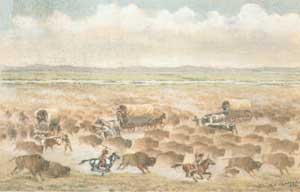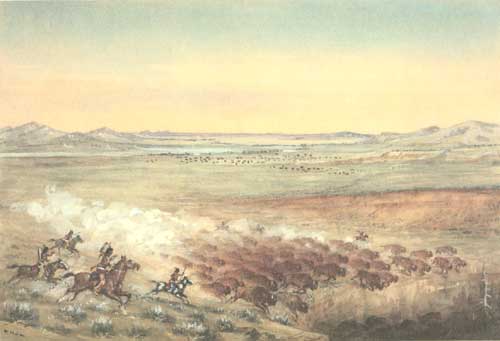
INTRODUCTION
By Marian Albright Schenk
FOREWORD
By Dean Knudsen
SECTION 1
Primary Themes of Jackson's Art
SECTION 2
Paintings of the Oregon Trail
SECTION 3
Historic Scenes From the West
 |
| When William Henry Jackson moved to New York in 1929 he decided to live in the Explorer's Club. In 1932 he moved into the Army and Navy Club. In this undated photograph, Jackson is seated in his room at the Explorer's Club, surrounded by some of his paintings. (SCBL 2644) |

Section 3: Historic Scenes from the West
BUFFALO HUNT
If any creature can be said to symbolize the American West, it would have to be the buffalo. Prior to the encroachment of the Euro-Americans, millions of the animals thundered across the high plains in single, massive herds. Native American tribes had hunted the buffalo for thousands of years.
Prior to the acquisition of the horse, Plains Indians could only hunt the buffalo herds on foot, and movement was limited by what they could carry. This lack of mobility limited the amount of game that could be taken and carried away at any one time.
To overcome these limitations, early native hunters sometimes drove buffalo over "jumps," where their herd instinct, poor vision and the shear weight of numbers would force the animals over a cliff. Those animals not killed in the fall could be dispatched with relative ease and safety.
The popular image of nomadic tribes following the herds of migrating buffalo and living free on the wide open prairie is accurate—to a point. But it should be remembered that the culture that evolved around the buffalo and the horse was a recent development, since only three generations of Lakota had lived on the Plains prior to the Lewis and Clark Expedition.1
 |
| In an explanatory note on the back of this painting, Jackson wrote, "On the plains pioneers frequently encountered vast herds of bison or buffalo, and at times met with serious difficulty." (SCBL 153) |
Before 1700 the prairies were very sparsely populated. Plains tribes spent most of the year in semi-permanent villages along the major rivers and relied on farming for subsistence, and only ventured onto the Plains to supplement their diets with annual buffalo hunts.2 The vast distances on the prairies simply made travel by foot impractical, and it was the acquisition of the horse that revolutionized the culture of the Plains Indians.
For example, the Sioux had been an eastern Woodland people living in Minnesota, and only became buffalo hunters when conflict with the larger Cree tribe forced them out onto the Plains in the late 18th Century.3 Their transformation into a culture based on the horse and buffalo was both rapid and stunning. No longer limited to traveling on foot, Sioux horsemen were able to follow the buffalo herds and raid enemy camps with impunity.
Other tribes developed similar cultures; the Cheyenne, Arapaho, Crow, Kiowa, and Comanche are primary examples of peoples who re-fashioned their cultures to suit their new Plains environment. The use of the horse and the mobility it offered made year-round life on the prairie possible. This culture which flowered for only a short time, developed such powerful cultural features—such as the tipi, flowing eagle feather headdresses, and sun dances, that they have become fixed in the mind of the general public as representing all Native American tribes.
William Henry Jackson had the good fortune to personally witness many of these Plains peoples before they were relegated to reservations, and their distinctive cultures were altered forever. This is undoubtedly the reason Jackson chose to portray an old-fashioned buffalo hunt in one of his paintings.
1. Royal B. Hassrick, The Sioux; Life and Customs of a Warrior Society (Norman: The University of Oklahoma Press, 1989), 64.
2. Robert H. Lowie, Indians of the Plains (Lincoln: The University of Nebraska Press, 1985), 13.
3. Hassrick, The Sioux, 62.
 |
| Indians Driving Buffalo Over a Cliff. Initialed and undated. 25.4 x 38.1 cm. (SCBL 157) |
 |
scbl/knudsen/sec3a.htm Last Updated: 14-Apr-2006 |
 |